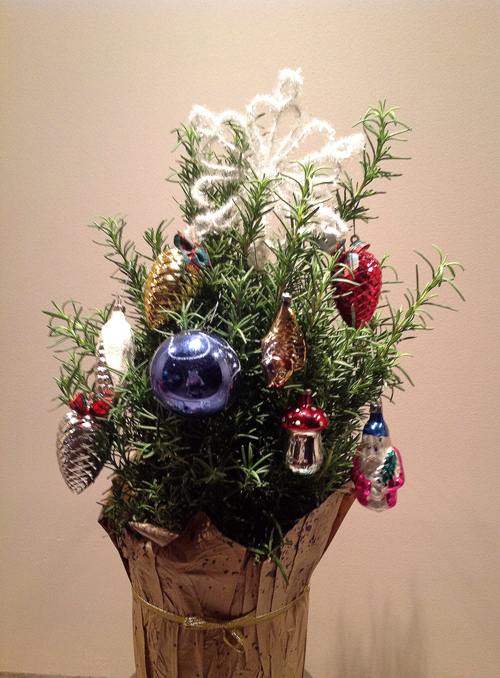Scientific name: Rosemarinus officinalis
Common name: Rosemary
Family: Lamiaceae (Mint)

Rosemary, an evergreen shrub often sold at Christmas time, sometimes as a small Christmas tree substitute. Photo by Jeanne Gozigian.
Article by Jeanne Gozigian
“Are you going to Scarborough Faire?
Parsley, sage, rosemary, and thyme.
Remember me to the one who lives there,
She once was a true love of mine.”
The Scarborough Faire was a medieval gathering of traders and entertainers, held annually in a small town on the coast of England. Parsley (Petroselinum crispum), Sage (Salvia officinalis), Rosemary (Rosemarinus officinalis), and Thyme (Thymus vulgaris), together were considered to be a love potion. This explains the repeated second line in all of the stanzas of the song Scarborough Fair, made famous by the duo of Simon and Garfunkel. From an old English folk song, it tells the sad story of lost love.
People of the time held great store in the properties of herbs and their effects on them. Parsley was valued as an aid to digestion, Sage represented strength, Rosemary faithfulness, love, and remembrance – perhaps even death, while Thyme signified courage. This article will focus on Rosemary, its cultivation and uses in gardens, folk medicine, and cosmetics.
Rosemary officinalis is an evergreen shrub in the Lamiaceae, or Mint family, like many other herbs. It is woody and perennial, native to the Mediterranean region. Its fragrant, needle like leaves are similar to hemlock, and it flowers with white, pink, purple, or blue blossoms from spring through summer. It is easiest to begin with a mature plant but it can be propagated with cuttings. Take 2- inch cuttings from soft, new growth, remove leaves from the bottom inch, dip in rooting hormone, and place in damp, sterile seed starting mix. Place in indirect sunlight. When rooted, pot up in small pots and pinch off to encourage branching.
Rosemary needs sun, good drainage, and air circulation. Fertilize with fish emulsion when planting outdoors; it also benefits from occasional spraying with the emulsion. In this area where winter temperatures go below freezing, the plants should be brought indoors, although I had large Rosemary bushes growing in a sheltered spot in my herb garden for several years, until they finally winter killed. Inside, they can be subject to powdery mildew. Rosemary resents wet feet, so allow the soil to dry out a bit between waterings, but do not let the soil become bone-dry. Spider mites and aphids could be a problem. It is a good idea to repot once a year, trimming back roots and moving to a larger container. It can also be shaped as are topiary hedges. Your large indoor Rosemary makes a lovely, fragrant, compact Christmas tree, with miniature ornaments and bows.
The medicinal uses of Rosemary are complex and amazing. Topically, the oil has been said to alleviate skin conditions such as eczema and help with wound healing. It is thought to have antiseptic properties and act as an insect repellant. It has traditionally been used for hair loss – male pattern baldness and alopecia. Theoretically, Rosemary’s volatile oils irritate the skin and increase blood circulation. The oil is added to soaps, perfumes, and shampoos.
Orally, like Parsley, it has been taken to relieve digestive problems. It is an antioxidant. There is a possibility that it can be effective in treating memory loss as in age related cognitive impairment – the herb of remembrance? While it can increase menstrual flow, too much can be an abortifacient and cause miscarriage. It is best to avoid ingestion of large amounts by pregnant and breast -feeding women, especially the oil, but regular culinary amounts are safe. Possible side effects can come from interaction with anticoagulants such as Coumadin and aspirin. As usual, we do not recommend the medical use of herbs; we only report the historical use.
In Italian cuisine, Rosemary is queen. It pairs wonderfully with lamb in stews and ragouts. Stuffed into the cavity of a roasting chicken, it gives the meat an intense flavor. It is a special ingredient in marinades. Rosemary can be used on all grilled meats and fish. Dropping fresh sprigs directly on burning charcoal adds smoky notes. The traditional bouquet garni, in soups and stews, consists of fresh Rosemary, Parsley, Sage, Thyme and Bay leaves; it is tied with twine and removed at the end of cooking. Create marvelous aromatic oil by first heating olive oil then adding fresh sprigs. As with Lavender lemonade, fresh Rosemary makes a refreshing summertime beverage; adding spirits turns it into a gourmet cocktail!
The derivation of the name, Rosemary, is from the Latin: Dew (ros), and sea (marinus), thus, “Dew of the Sea”, a fitting name for an extraordinary plant.


